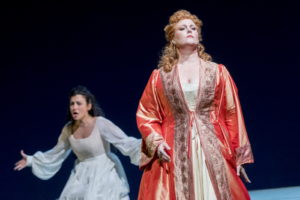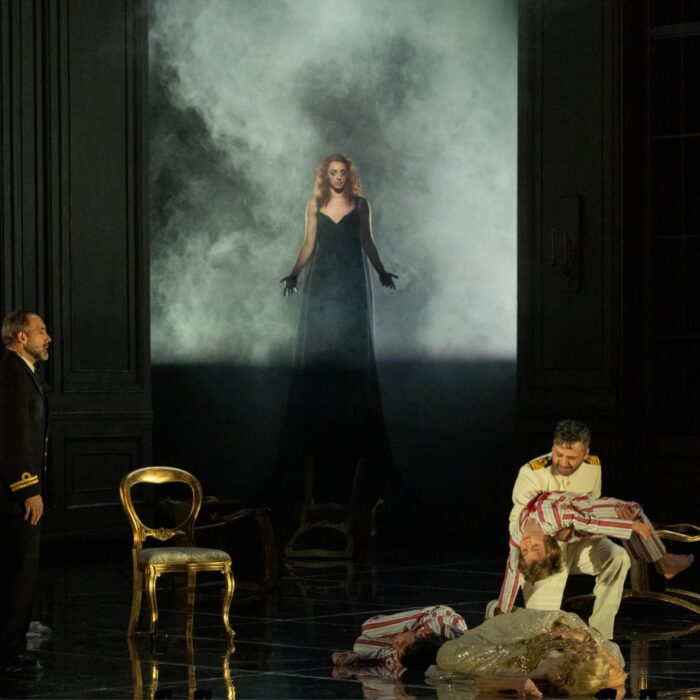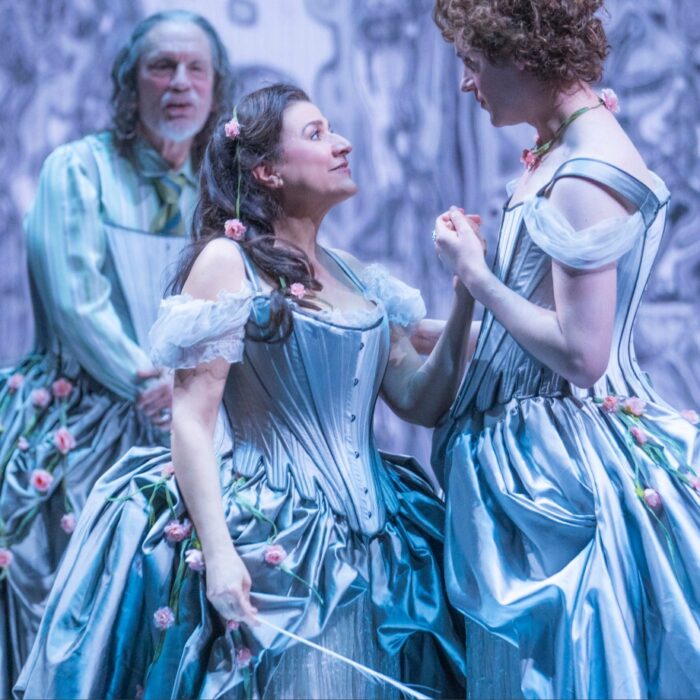
Donizetti Opera Festival 2018 Review: Il Castello di Kenilworth
Jessica Pratt & Carmela Remigio Lead Solid Cast In Donizetti’s Often-Overlooked Work
By Alan NeilsonDonizetti certainly had an intimate relationship with England’s Queen Elizabeth I, and with the Tudors in general, who provided him with a rich source of characters and themes for his operas. Three works have substantial roles for Elizabeth, herself; “Maria Stuarda” and “Roberto Devereux” are well-known and receive regular performances, whereas the third, “Il Castello di Kenilworth,” rarely receives a staging.
It has also been subject to a fair amount of criticism over the years: it is formulaic, in terms of Donizetti’s musical and dramatic stylistic development it has little of interest, and the motivations of its characters are unconvincing, which at best, can be considered to be a little thin – its happy ending almost making a mockery of its preceding events.
The praise it has received has been equally lukewarm, credited for being energetic, and for having pleasing, ceremonial (rather than expressive) embellishments. It is excused on the grounds that Donizetti was struggling with illness, and under pressure to meet the deadline for the Queen of Naples’ birthday celebrations. At least, this has been the received wisdom.
Re-Evaluating the Work
For this year’s Donizetti Opera Festival, in the composer’s hometown of Bergamo, a new production of the opera is currently being presented, and it is one that may lead to a re-evaluation of the work.
A first-class cast, with an imaginative production team, under the musical direction of Riccardo Frizza, have been assembled, and it is not an exaggeration to say that together they have produced a compelling case for “Il Castello di Kenilworth” to be given further consideration. It was musically engaging, full of bel canto charm, with some wonderful melodies, and notwithstanding its formulaic format, was dramatically convincingly; its narrative may, indeed, be weak in the hands of a less accomplished director, but Maria Pilar Perez Aspa’s interpretation made a nonsense of the claim that the motivations which drive the drama forward are superficial. Moreover, it showed itself to be an excellent vehicle for singers to display their technique and the beauty of their voices.
The libretto by Andrea Leone Tottola is set in Kenilworth castle, the seat of the Earl of Leicester, the Queen’s favorite, who is secretly married to Amelia. The impending visit of the Queen, however, causes a huge problem, for not only will she be furious that Leicester has married, but Leicester, himself, now risks losing his power as the Queen’s favorite.
He, therefore, hides Amelia, and hopes for the best. Unsurprisingly, Amelia reacts badly to the situation, and not only confronts her husband over the matter, but eventually the Queen herself, a situation which prefigures the scene from “Maria Stuarda,” albeit on a much less grand scale.
Amelia is then imprisoned by the Queen. The plot is made more complicated by the presence of Warney, who also loves Amelia, which leads to another round of confrontations. She rejects him, so Warney sets out to poison her in her prison cell, but is thwarted by the timely arrival of her husband. The Queen then appears and forgives the couple, as all wise and benign sovereigns eventually do, and blesses their marriage.
Imprisoned Women & Weak Men
Certainly, at first glance the narrative is not strong, and the motivations of Warney and the Queen, not to mention her volte-face, verge on the ridiculous. However, Aspa pays close attention to the context in which the events are occurring, and to their incumbent social and psychological pressures, as well as to the clash between love and the desire for power, which impact upon the characters, to create a fully believable and powerful interpretation.
Each character is carefully explored in terms of the prison which constrains their behavior, and from the psychological pressures which precipitate their actions. It is not just Amelia who is imprisoned, for Elizabeth is a captive too, imprisoned in a golden cage of her own making. In a male-dominated world, in which women are seen as unfit to govern, she risks losing her power if she marries, and must suppress her desire for a more intimate relationship. Her relationship with Leicester is, therefore, complex and subject to far wider pressures than is normal. Her jealousy of Amelia is understandable, yet so is her eventual change of heart.
While Aspa maintains the original ending, she cleverly alters its meaning; as Elisabetta blesses the happy couple, prison bars arise from the floor, isolating her from the rest of the cast, who walk off, leaving her alone, crumpled on the floor.
She may have been physically imprisoned by the Queen, but Amelia’s imprisonment is far more severe and long lasting, for she is a woman in a world in which men are the masters. The fact that Leicester actually imprisons her, his own wife, in order to preserve his own ambitions, says everything. Aspa portrays Amelia, not just as woman reacting emotionally to her torment, but of a woman on the precipice of madness itself, fighting against her husband’s betrayal, her jealousy of the Queen and against Warney’s attempts to bully her into a sexual relationship. Aspa has her imprisoned for large parts of the performance in a physical cage, which she is able to wheel across the stage, representing her existential reality.
The male protagonists are admittedly less interesting and less convincing. Leicester is indecisive, at times sentimental, and ambitious for power, but without the vicious single-mindedness that makes him credible.
Aspa likens Warney to Iago, but this gives the character too much weight, for Warney is reacting to short-term emotions, to his rejection by Amelia. Iago is not weak, he revels in his own evil nature, enjoying the destruction of others. He is cold and calculating, not reactive or trivial. Both, Leicester and Warney, are nevertheless prisoners, enslaved by their own passions and the pressures of masculine aggression which underpinned Elizabethan England, and to this extent, they are weak characters when contrasted with the female roles, who are both fighting to assert their positions within the society.
Angelo Sak was responsible for scenography and did a fabulous job. Clearly working from the premise that less can mean more, Sak kept props to a bare minimum, and the stage design was simplicity itself – a slightly raised platform, tilted towards the front, with a single white cloth behind. If this sounds fairly drab, be assured it was not.
Colored lighting, designed by Fiammetta Baldiserri, projected onto the back canvas, perfectly captured the moods of the drama, while the traditional costumes, designed by Ursula Patzak, were wonderfully highlighted in the foreground. In fact, it was so effective that, apart from Amelia’s prison bars and Elizabeth’s dress suspended from above the stage, the props if anything distracted from the spectacle. Moreover, by dispensing with the extraneous, the focus was concentrated on the inner suffering of the characters, which is exactly where the power of the work lies.
A Regal Monarch
Jessica Pratt put in a truly regal performance in the role of Elisabetta, hiding her vulnerability behind a hard exterior, until the final scene when she finally succumbs to the loneliness she has had to create for herself.
Elisabetta first arrives on stage at the end of Act one, cheered by her subjects. It is here we are made aware of her public and private personae, the two competing spheres which she is attempting to manage. As she thanks her subjects and promises them good fortune, privately she is fearing Cupid’s influence. Publicly she remains aloof, singing with precision, exactitude and a paternal and unyielding edge, but privately sings with greater flexibility and emotional honesty.
Pratt’s marvelous characterization and vocal control managed to contrast her conflicting personae within this short scene, laying down the foundation for a compelling portrait, one in which the beauty of her voice shone brightly.
In Safe Hands
To a large extent, the drama revolves around the role of Amelia, who unlike Elisabetta, is free to give full reign to her emotions. Played by Carmela Remigio, it is unlikely that the role could have been put in a safer pair of hands, for not only is Remigio a consummate singer with the ability to bring emotional depth to her character, but she is also an excellent actress.
Her Amelia was always one step away from a breakdown, as she was subjected to the outrageous pressures of betrayal, imprisonment, jealousy, terror, attempted assassination and much more, as well as psychologically difficult conflicts with the Queen of England, her husband and a spurned suitor seeking revenge.
Remigio’s ability in characterizing the various emotions was impressive; her ability to mold the vocal line with cleverly placed inflections alongside dynamic and colorful shadings produced a finely detailed portrayal of Amelia’s emotional changing states. In Act three, as her emotional state starts to overwhelm her, Remigio sings the aria, “Par che mi dica ancora,” to which she brought a gripping intensity as her delusions start to run out of control, verging on a mini-mad scene.
In Act two, Amelia confronts Elisabetta, in a scene which would be developed with far greater force and emotional weight in Elisabetta’s confrontation with Maria in “Maria Stuarda.” In this opera, however, although not without merit, it fell a long way short of the more famous piece.
Two Tenors
The Earl of Leicester was essayed by Xabier Anduaga. He possesses a sweet tenor with an attractive timbre, which is secure across the range, flexible and strong. During his Act one aria, “Veggo… ahimé! la ingenua sposa,” he showed off his excellent technique as he mused over his conflicted feelings for his wife and how it might affect his path to the throne, the flexibility of his phrasing nicely capturing his character.
Scene four of Act two is taken up by an extended duet in which Amelia laments the fact he does not love her, while he, taken by her pleading, starts to melt. It was a wonderfully managed confrontation, both voices combining in a deeply emotional exchange, full of heartfelt pathos.
Originally the part of Warney was written for a tenor, however Donizetti changed it to a baritone for the opera’s revival the following year. In this production they have have reverted to casting the role for a tenor, which was wondrously undertaken by the free singing Romanian, Stefan Pop.
The role seems ideal for Pop’s strong lyrical voice, which soars effortlessly and stretches out long lines with ease. In the past he has appeared to sacrifice a degree of characterization for vocal beauty, on this occasion, however, no such compromise was evident, although his acting skills are still fairly basic. His aria, “Taci amor! Se amica speme,” was wonderfully rendered, sung with passion and emotional power. His first act duet with Amelia, in which he attempts to force a relationship with her was yet another heated exchange, Pop and Remigio’s voices sparking off each other as their growing frustrations and anger spiraled upwards, the voices matching each other in a scintillating emotional duel.
Lambourne was impressively played by Dario Russo, who produced an authoritative performance, showing off his beautifully warm vocal timbre. The small role of Amelia’s servant, Fanny, was successfully played Federica Vitali, who also gave a convincing performance.
Musical Master
The Coro Donizetti Opera under the direction of the Maestro del Coro, Fabio Tartari, gave a spirited and convincing display and added greatly to the spectacle.
The conductor, Riccardo Frizza, who was appointed as the Festival’s Music Director last September, gave ample evidence that he is the right person for the position, eliciting a strong performance from the Orchestra Donizetti Opera.
From the opening sinfonia onwards, Frizza produced a cleanly articulated sound, in which the textural subtleties of the score were clearly audible. He closely monitored tempi and dynamics, not only capturing, but also enhancing, the dramatic momentum of the drama. As well as maintaining a good balance between all the musical forces, it was also a performance in which Frizza allowed the orchestra’s voice to be heard in its own right, and not just as an accompaniment to the singers.
After watching this production by the Donizetti Festival it is strange, indeed, that “Il Castello di Kenilworth” has been so long overlooked. This is an opera with a lot to admire. Certainly, if you want to make a direct comparison with“Lucia di Lammermoor,” or “Maria Stuarda,” then it will come off second-best, but so too would many other operas who receive regular performances.


